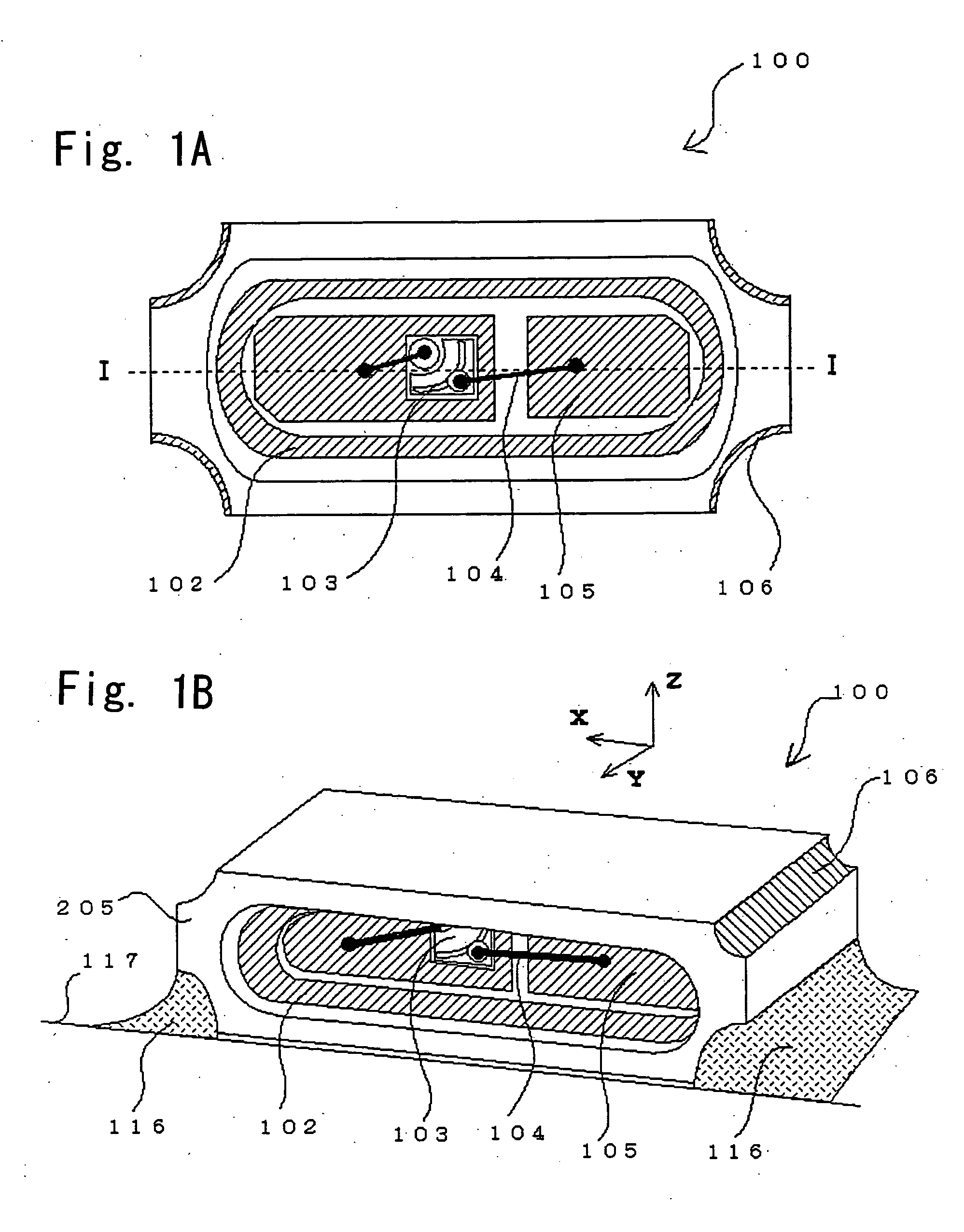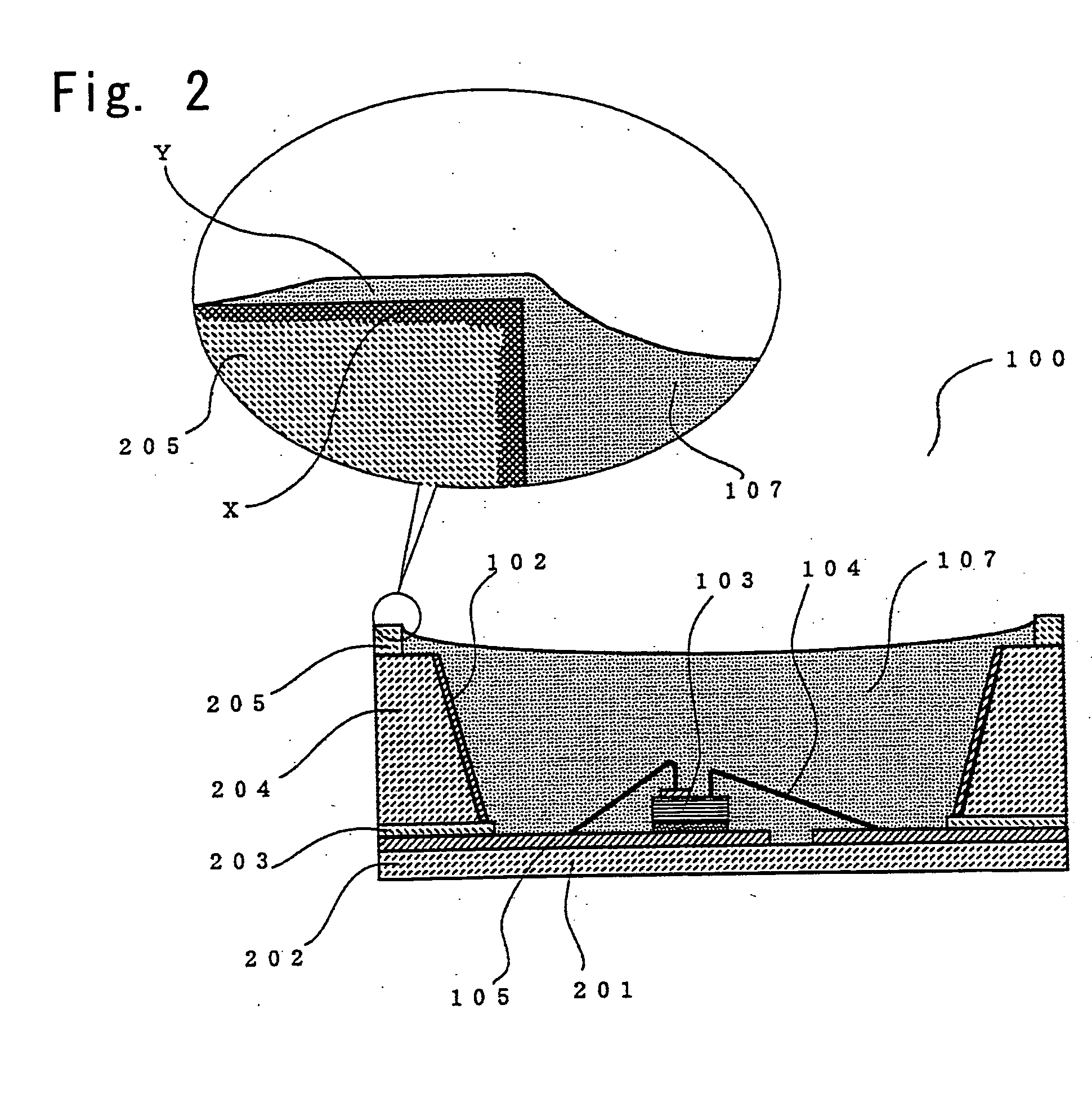Support body for semiconductor element, method for manufacturing the same and semiconductor device
- Summary
- Abstract
- Description
- Claims
- Application Information
AI Technical Summary
Benefits of technology
Problems solved by technology
Method used
Image
Examples
example 1
[0171] Example 1 of the present invention will be described with reference to the accompanying drawings. FIG. 1A is a schematic top view of a light emitting device 100 that uses the ceramics package and the light emitting element according to this embodiment. FIG. 2 is shows a sectional view taken along lines C-C′ in FIG. 1 and an enlarged sectional view of a portion around the top face of the recess side wall. FIG. 1B is a perspective view schematically showing the semiconductor device of this embodiment being electrically and mechanically connected by soldering to the mounting surface where the wiring pattern has been formed.
[0172] The ceramics package of this embodiment comprises at least a ceramics base 202 serving as the substrate, and a ceramics base 204 having through hole that widens toward the opening. The ceramics base 202 that serves as the substrate has the electrical wiring 105 for supplying power to the LED chip 103 running from the bottom of the recess on the package...
example 2
[0186]FIG. 8 is a schematic sectional view of the light emitting device of this example. The sealing member 107 of this example is formed so as to cover at least the light emitting element 103 without covering the reflecting surface 102. As indicated by Y in the enlarged sectional view of FIG. 8, the silicone resin covers the top face of the recess side wall of the ceramics package. In addition, a part of the silicone resin impregnates the ceramics base 204 that forms the top face of the recess side wall and forms an impregnated portion X. In this example, since the solder is restricted from creeping up by the silicone resin that covers the top face of the recess side wall, the solder that has been reflowed never touches the reflecting surface 102. Therefore, mounting can be carried out with high reliability as short-circuiting does not occur between positive and negative electrodes when mounting the device on an external circuit board that has electrical circuit formed thereon.
example 3
[0187] The light emitting device of this example is formed similarly to Examples 1 and 2, except for containing fluorescent material in the sealing member.
[0188] Stock material for the fluorescent material is made by coprecipitating a solution of a mixture of rare earth elements Y, Gd, Ce in stoichiometrical proportions dissolved in an acid with oxalic acid, firing the product of coprecipitation to obtained a coprecipitated oxide, and mixing it with aluminum oxide. This mixture, with a fluoride such as ammonium fluoride added thereto as a flux, is put into a crucible and fired at a temperature of about 1400° C. in air for three hours. The fired mixture is crushed in a ball mill in wet process, and undergoes the processes of washing, separation, drying and sieving, thereby to obtain a fluorescent material (Y0.995Gd0.005)2.750A15O12:Ce0.250 having median particle size of 8 μm.
[0189] 5.5% by weight of the fluorescent material (refractive index 1.84) is added to the silicone resin com...
PUM
 Login to View More
Login to View More Abstract
Description
Claims
Application Information
 Login to View More
Login to View More - R&D
- Intellectual Property
- Life Sciences
- Materials
- Tech Scout
- Unparalleled Data Quality
- Higher Quality Content
- 60% Fewer Hallucinations
Browse by: Latest US Patents, China's latest patents, Technical Efficacy Thesaurus, Application Domain, Technology Topic, Popular Technical Reports.
© 2025 PatSnap. All rights reserved.Legal|Privacy policy|Modern Slavery Act Transparency Statement|Sitemap|About US| Contact US: help@patsnap.com



